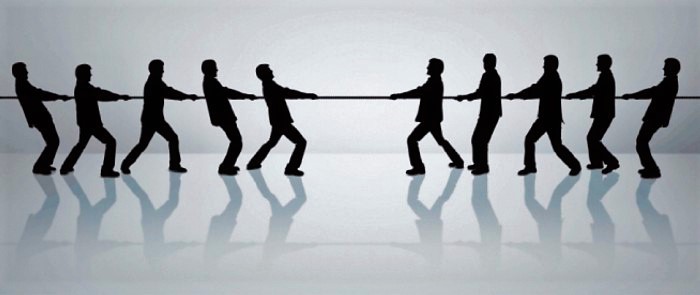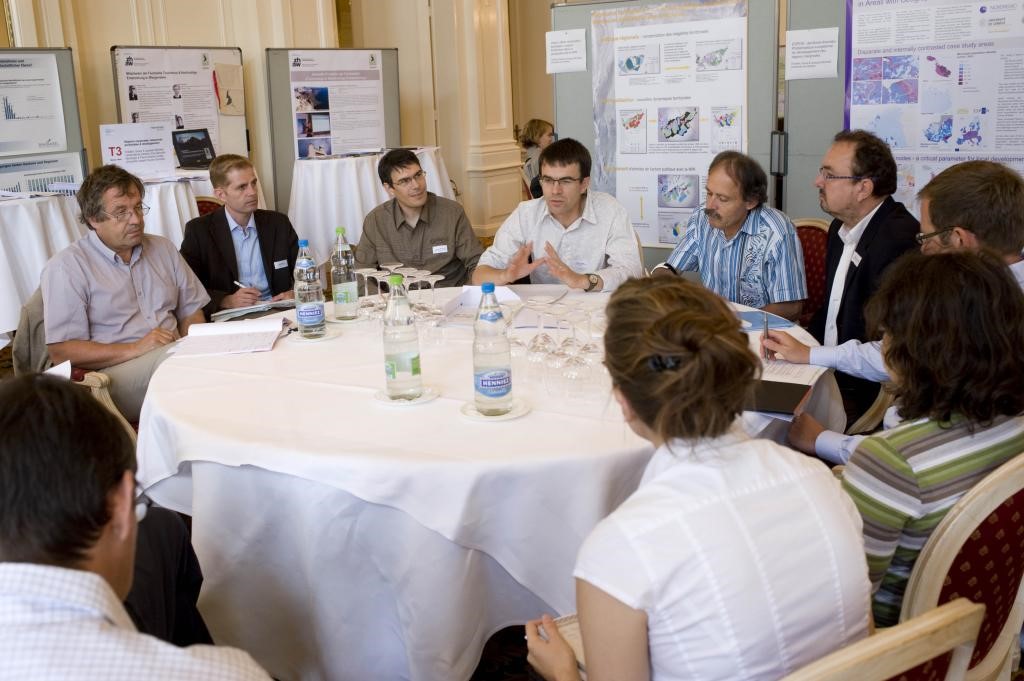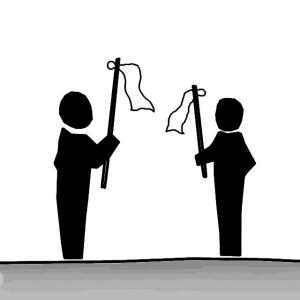In the process of optimising your local water and sanitation system, it is very likely that you will face conflicts between groups or individuals, especially when it comes to decision-making. A conflict can be defined as a disagreement through which the parties involved perceive a threat to their needs, interests or concerns. Conflict management offers approaches that help in preventing or resolving conflicts. It is a broad concept that cannot be described simply as a “tool”. Nevertheless, a number of key steps can be identified in many approaches to conflict resolution (MORIARTY et al. 2007). Here, we focus on the community level; that is conflict management for small groups or individuals.
Sustainable sanitation and water management issues are complex and political systems often involve a great number of stakeholders (see stakeholder identification and stakeholder importance and influence) with different, often conflicting agendas (MORIARTY et al. 2007). Also, change almost always brings about conflicts between the needs and wishes of different groups or individuals. Conflict prevention by consensus building and when applicable by conflict resolution, are needed to win the support of a maximum of stakeholders in order to optimise your local water and sanitation system (CDI 2010). Conflict management offers approaches that help in preventing or resolving conflicts.
Conflict is often seen as a purely negative element in a change process – or at least one with a strong negative potential. Conflict management however recognises that conflicts are a normal part of life and if well managed they can be an important force for positive change (CDI 2010).

Anyone is potentially capable of learning how to constructively deal with conflicts. But you have to keep in mind that conflict situations should not be taken lightly. In difficult cases, you should consider appointing a mediator - a neutral facilitator who understands conflict management and develops a thorough knowledge of the interests and perceptions of stakeholders. It is important that someone that is seen to have no stake in the original disagreement manages conflict resolution. You cannot expect a member of local government staff to mediate a conflict between villagers and local government!
(Adapted from OHRD 2010)
One key element of conflict resolution is the idea that each party may have a different perception of any given situation. People filter their perceptions and reactions through their values, culture, beliefs, information, experience, gender, and other variables. This means that we can anticipate that in many conflicts there will be significant misunderstanding of each other's perceptions, needs and feelings. We can anticipate having such differences due to a number of factors that create "perceptual filters" that influence our responses to the situation:
Culture, Race, and Ethnicity (see water sanitation and culture):
Our different cultural backgrounds influence us in holding certain beliefs about the social structure of our world, as well as the role of conflict in that experience. We may have learned to value certain needs differently as a result, thus influencing our willingness to engage in various modes of negotiation and efforts to manage the conflict.
Gender and Sexuality (see water sanitation and gender):
Men and women often perceive situations somewhat differently, based on both their experiences in the world and socialisation patterns that reinforce the importance of relationships vs. task, substance vs. process, immediacy vs. long-term outcomes. As a result, men and women will often approach conflictive situations with differing mindsets about the desired outcomes from the situation, as well as the set of possible solutions that may exist.
Knowledge:
Parties respond to given conflicts on the basis of the knowledge they may have about the issue at hand. Such information can influence the person's willingness to engage in efforts to manage the conflict, either reinforcing confidence to deal with the dilemma or undermining one's willingness to flexibly consider alternatives.
(Adapted from MORIARTY et al. 2007)
Although the following series of steps is designed to help you manage potential conflict situations, you have to keep in mind that resolving conflict is not a mechanical process in which applying steps “A” through “Z” guarantees a positive outcome (NRCS 2005).
Step 1: Diagnose the situation. Determine the conflict’s content and history. Evaluate personalities and positions. If defined objectively, conflict can lead people to agree: “We need a new way of doing things, the old way has failed.” If two sides can define what they are fighting about, the chances of clarifying any misperceptions increase.
Step 2: Involve all parties. Be a skilful questioner by asking open-ended questions. Use processes that solicit discussion, opinions, information, priorities, etc. from all people.
Step 3: Depersonalise the conflict.Try to move “you against me” towards “you and me against the problem”. For example, not irrigators versus livestock keepers; but water users facing a problem of lack of water. Often win-win solutions can be identified through re-examining the problem. Even if there are no perfect solutions, understanding the “it is the problem that is the problem” can lead to a greater acceptance of relative losses and gains.
Step 4: Collect all information. There are many ways to gather information; e.g. use facts, historical records, data, maps, ideas from around the table, unbiased experts, and interviews. Remember, people’s feelings are just as real to them as facts.
Step 5: Reinforce agreements. Focus on commonalities – not differences. Identify shared concerns of parties to the conflict, rather than focusing on the disagreements.
People who disagree often share some common goals and common values. Discover these common concerns and reinforce agreements. Write these agreements so that everyone can see them.
Step 6: Negotiate disagreements. Disagreements are not negotiated until everyone understands the facts and feelings that caused the conflict. Review steps 1 through 5; list important disagreements; have everyone rank order their disagreements; begin with the smallest issue and work toward the largest.
Step 7: Solidify agreements. Identify agreed upon solutions and offer compromises for unresolved issues. If a compromise cannot be reached, table the issue and move to the next issue; review any proposed agreements carefully so you are sure that everyone understands them.Remember, ending conflict cannot always be done quickly. If it took a long time for the dispute to begin, it will take time to end it. Work on one small doable problem rather than on many large currently irresolvable issues.

(Adapted from NRCS 2005)
There are knowledge, tips and skills you can learn that will enable you to manage conflict more effectively.
Knowledge in Organisational Settings:
- Identify neutral spaces. When conflict has occurred, particularly linked to a specific environment (office, district etc.), it is important that conflict management takes place somewhere that is felt to be neutral by both sides and away from the environment of conflict.
- Be observant of physical conditions of the meeting site; e.g. confined, hot areas can intensify conflicts; outdoor meetings can reduce tensions.
- Round tables or sitting in a circle give everyone equal seating status.
- Rectangular tables have two dominant seats – the head and foot of the table. Try not to allow antagonists to sit in these seats. Sit in one of these seats, yourself, if you are facilitating a meeting.
- If possible, sit potential antagonists side by side, not across from one another.
- Call breaks if a situation gets heated.
Communication Tips:
- An effective communicator is a good speaker, keen observer, smiles at appropriate times, provides feedback, and can use humour to diffuse a situation and keep everyone at ease.
- Establish ground rules and verbalise or display them: e.g. everyone has the opportunity to talk uninterruptedly; discuss one topic or problem at a time; everyone needs to treat each other with respect.
- Verify that you understand what a speaker says by summarising their statement (e.g. “...so it’s the inflexibility of the rules that bother you.”).
Listening Skills:
Look for nonverbal messages and their meaning. Some are listed below:
- Alert and agreeable: sitting upright, good eye contact, quick to respond, arms open.
- Signs of aggression: leaning forward, pointing, standing/sitting close, rapid or loud speech, glaring, interrupting others.
- Disagreement with the message: arms folded, turned away from speaker, poor eye contact.
Generally, the process of conflict management can be used at any time, in a one-on-one or group setting. It can be applied at the office, in the field, or at home. But if the conflict is linked to a specific environment (office, district etc.), it is important that conflict management takes place somewhere that is felt to be neutral by both sides and away from the environment of conflict.
Power issues may arise when specific groups (e.g. women) have less access to resources or to decision-making. Sometimes this may even be embodied in the policies or legislation (see policies and legal framework) of the country.
Communication tips and skills are not necessarily the same for all cultural groups or countries. Consequently, you may need to modify your approach with regard to the specific values, culture, beliefs, information, experience, gender etc. of the respective setting you are in.
Conflict Management. Participatory Planning, Monitoring and Evaluation
Managing Conflict of Interest
The EMPOWERS Approach to Water Governance: Guidelines, Methods and Tools
The guideline provides information necessary to understand the EMPOWERS approach of water governance and explains in details how to use the approach for planning and implementation of water management and related issues.
MORIARTY, P. BATCHELOR, C. ABD-ALHADI, F. LABAN, P. FAHMY, H. (2007a): INWRDAM The EMPOWERS Approach to Water Governance: Guidelines, Methods and Tools. pdf presentation. Amman, Jordan: Inter-Islamic Network on Water Resources Development and Management (INWRDAM) URL [Accessed: 18.03.2010]Conflict Management
This three-page factsheet provides short but top-notch information about conflict management. It presents knowledge, tips and skills that are useful in conflict resolution and describes steps to manage a potential conflict.
NRCS (2005): Conflict Management. Greensboro: Natural Resources Conservation Service (NRCS), The U.S. Department of Agriculture (USDA), Social Sciences Team URL [Accessed: 08.07.2019]Conflict Resolution
Forschungsmarkt Regiosuisse
Conflict Management. Youth Leadership Development. Training Materials
This bulletin gives ideas and provides activities on how to help manage conflict within groups. Skills like effective communication, problem solving, and negotiating are presented in a very comprehensible way. Therefore, it could also be used when working with youth.
CAS (2008): Conflict Management. Youth Leadership Development. Training Materials. Pennsylvania: College of Agricultural Science (CAS) at Penn State University. [Accessed: 26.04.2011] PDFParticipation, Concensus Building and Conflict Management Training Course
This training course teaches a set of skills that will help water resources decision makers prevent conflict, deal with conflict should it arise, and use water decisions as a venue for dialogue when others are closed to parties locked in various types of non-water conflicts. Topics include: Identification of the characteristics of effective participatory, consensus building, and conflict management processes. Identification of behaviours that escalate conflict during a dispute with other agencies, stakeholders, or the public – and identification of behaviours that halt this escalation.
DELLI PRISCOLI, J. (2003): Participation, Concensus Building and Conflict Management Training Course. Paris: UNESCO – Division of Water Sciences URL [Accessed: 08.07.2019]Water and Conflict. Policy briefing for USAID
This briefing tries to raise awareness of the links between water issues and conflict and focuses on integrating conflict prevention and natural resource management. The paper discusses direct links between water and conflicts as well as indirect links. In addition, several options and instruments of conflict management are presented.
KRAMER, A. (2004): Water and Conflict. Policy briefing for USAID. Washington DC: Adelphi Research, Center for International Forestry Research, Woodrow Wilson International Center for Scholars URL [Accessed: 08.07.2019]Conflict Analysis Tools - Tip Sheet
The conflict analysis tools tip sheet summarises seven tools that can be used to assess different conflict characteristics in a more structured way. The aim of the tools is to make subjective conflict perceptions more transparent, and to enhance reflection and communication. The tools presented are: Conflict wheel, conflict tree, conflict mapping, glasl's escalation model, conflict perspective analysis, needs-fears mapping, and a multi-causal role model.
MASON, S. RYCHARD, S. (2005): Conflict Analysis Tools - Tip Sheet. Bern: Swiss Agency for Development and Cooperation (SDC), Conflict Prevention and Transformation Division (COPRET) URL [Accessed: 08.07.2019]Conflict Management
This three-page factsheet provides short but top-notch information about conflict management. It presents knowledge, tips and skills that are useful in conflict resolution and describes steps to manage a potential conflict.
NRCS (2005): Conflict Management. Greensboro: Natural Resources Conservation Service (NRCS), The U.S. Department of Agriculture (USDA), Social Sciences Team URL [Accessed: 08.07.2019]Training Manual on Conflict Management
The training manual on conflict management is meant for leaders of different categories as a tool to assist them in managing potential conflicts likely to emerge. The main parts constituting this manual are the following: the concept of conflict, conflict analysis, causes of conflict, the way people respond to conflict or styles of behaviour, conflict prevention and resolution mechanisms. In addition, the document provides practical exercise.
NURC (2006): Training Manual on Conflict Management. Kigali: The National Unity and Reconciliation Commission (Republic of Rwanda). [Accessed: 26.04.2011] PDFConflict Management
The „Community Organisers Toolbox“ by the Education and Training Unit (ETU) in Johannesburg contains simple guides on a wide range of skills that are useful for community organisers. The section on conflict management in organisations presents topics like: How to identify signs and stages of conflict; how to build teamwork and co-operation and to thus minimise the possibility of conflicts; how to manage and resolve conflict situations.
Conflict Sensitivity
The conflict sensitivity website aims to understand what “conflict sensitivity” means in practice, in terms of organisational systems as well as during the design, implementation, monitoring and evaluation of specific interventions. It provides information on understanding conflict risk through a series of practical documents, including: Introduction to conflict-sensitive business practice, screening tool for early identification of conflict risk, macro-level conflict risk and impact assessment tool, and project-level conflict risk and impact assessment tool.
WaterWiki.net - The Wiki for Water Professionals worldwide
This Waterwiki-page gives an overview of approaches to prevent, minimise or manage conflicts in local water management projects. The article discusses ways to prevent or minimise such conflicts that can be incorporated into the design of a project and methodologies for resolving conflicts when communities are faced with such situations.
Berghof Foundation
The online platform of the Berghof Handbook for Conflict Transformation presents knowledge and experience for scholars and practitioners working on transforming violent ethnopolitical conflict. The website has three primary aims: fostering critical discussion both among and between academics and practitioners; bridging the gap between theory and practice in the field of conflict transformation; and including a wide range of voices and perspectives from different regions throughout the world, as well as from multiple disciplines and faculties.
INCORE (International Conflict Research Institute)
INCORE (International Conflict Research Institute) promotes conflict resolution management strategies. It aims at influencing policymakers and practitioners involved in peace, conflict and reconciliation issues while enhancing the nature of international conflict research. Issue sheets, publications and other resources can be downloaded.


